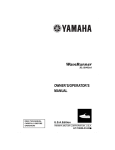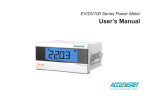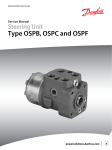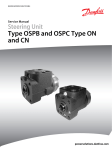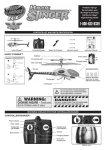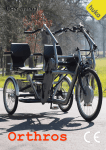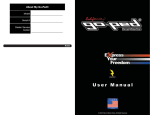Download Yamaha TT-R230TC Specifications
Transcript
TT-R230T TT-R230TC ASSEMBLY MANUAL LIT-11666-18-40 1C6-F8107-10 FOREWORD This Assembly Manual contains the information required for the correct assembly of this Yamaha motorcycle prior to delivery to the customer. Since some external parts of the motorcycle have been removed at the Yamaha factory for the convenience of packing, assembly by the Yamaha dealer is required. It should be noted that the assembled motorcycle should be thoroughly cleaned, inspected, and adjusted prior to delivery to the customer. SYMBOLS USED IN THE ASSEMBLY MANUAL In order to simplify descriptions in this assembly manual, the following symbols are used: Coat with lithium-soap-base grease. Tighten to 10 Nm. (10 Nm = 1.0 m • kg = 7.2 ft • lb) NOTICE The service specifications given in this assembly manual are based on the model as manufactured. Yamaha Motor Do Brasil Ltda is continually striving to improve all of its models. Modifications and significant changes in specifications or procedures will be forwarded to all authorized Yamaha dealers and will appear in future editions of this manual where applicable. The procedures below are described in the order that the procedures are carried out correctly and completely. Failure to do so can result in poor performance and possible harm to the motorcycle and/or rider. Towards the front of the motorcycle. Clearance required. Install so that the arrow mark faces upward. Apply motor oil. Made of rubber or plastics CONCERNING CRA TE DAMAGE : CRATE Follow the instructions in the Dealer Warranty Handbook, Procedure Section. Particularly important information is distinguished in this manual by the following notations. The Safety Alert Symbol means ATTENTION! BECOME ALERT! YOUR SAFETY IS INVOLVED! Failure to follow WARNING instructions could result in severe injury or death to the motorcycle operator, a bystander, or a person checking or repairing the motorcycle. A: Ref No. (indicating the order of operations.) B: Part name C: Quantity of parts per machine. D: Place where parts are held. V: Stored in plastic bag. C: Stored in carton box. S: Fixed inside the steel frame, and/or contained in the Styrofoam tray (upper or lower). *: Temporarily installed or secured. E: Size or material of parts. d/D:Diameter of part. l: Length of part. A CAUTION indicates special precautions that must be taken to avoid damage to the motorcycle. e.g., 5= 5mm (0.2 in) A NOTE provides key information to make procedures easier or clearer. TT-R230T / TT-R230TC ASSEMBLY MANUAL © 2004 by Yamaha Motor Do Brasil Ltda. First Edition, December 2004 All rights reserved. Any reproduction or unauthorized use without the written permission of Yamaha Motor Do Brasil Ltda is expressly prohibited. Printed in U.S.A. P/N LIT-11666-18-40 SETUP PROCEDURES 3 9 2 1 4 5 6 7 8 A B 0 C 1. Handlebar D A 1 2 Handlebar Upper handlebar holder 1 2 C V 3 Flange bolt 4 V d=8 (0.32), L= 35 (1.38) A: Clean the right handlebar end. Apply light coat grease C: Align the punch mark on the handlebar with the top of the B: Install the handlebar holders with the arrow mark facing forward lower handlebar holders. D: Tighten the bolts to specification. Tightening torque: 23 Nm (2.3 m.kg, 17 ft.lb) First tighten the bolts on the front side, and then tighten the bolts on the rear side. C 2. Front wheel 1 Front wheel 1 S 2 3 Wheel axle Collar 1 2 * V 4 5 Washer Axle nut 2 1 * * A: Clean the brake disc. B: Clean the front wheel axle. C: Clean the collar. D: Do not depress the brake lever when the caliper is off the brake disc. F: Tighten Take care not to get grease on the brake disc or inner surface of the brake pads. If you do so, clean using a rag dampened with a solvent. Foreign material on braking surface can cause impaired braking action E: Lift the front wheel and install the front wheel axle. -4- the axle nut specification. Tightening torque: 80 Nm (8.0 m.kg, 58 ft.lb) to 3. Front fender 1 2 Front fender Number plate holder 1 1 S C 3 4 Collar Collar 2 2 V V d=6 d=6 L=13,5(0,53) 5 6 Washer Bolt 2 4 V V d=6 (0,24) d=6 (0,24 L=30(1,2)) 1 2 * * d=5 (0,20 L=16 (0.63)) d= 3 (0,12),L= 14 (0,55) Tightening torque: 7 Nm (0.7 m.kg, 51 ft.lb) 4. Trottle grip 1 2 Trottle grip Panhead screw A: Check the throttle grip for smooth action. Proper cable routing is essential to assure safe motorcycle operation. Refer to “CABLE ROUTING”. Tightening torque: 4 Nm (0.4 m.kg, 3,9 ft.lb) 5. Start switch 2 3 1 4 -5- 1 2 Start switch Panhead screw 1 1 S V 3 4 Start switch holder upper Start switch holder lower 1 1 V V 6. Master cylinder 1 2 Master cylinder Master cylinder bracket 1 1 S * 3 Bolt 2 * d=6 (0,24) L=25 (0,98) 1 A: Lubricate the pivoting part of the brake lever. C A Proper hose routing is essential to assure safe machine operation. Refer to “CABLE ROUTING”. Recommended lubricants: Yamaha cable lube or motor oil B: Make sure that the “UP” mark on the bracket is pointed upward. C: Check the brake lever for smooth action. 2 UP 3 B Tightening torque: 9 Nm (0,9 m.kg, 6.5 ft.lb) 9 7. Clutch cable 1 Clutch cable 1 * 2 Clutch switch lead 1 S A: Lubricate the pivoting part of the clutch lever. Recommended lubricants: Yamaha cable lube or motor oil B: To install the clutch cable, be sure to proceed as follows: a.Turn in the adjuster on the lever holder until tight. Next, align the slit in the adjuster and cable socket with the slit in the lever holder. b.Insert the cable end into the lever hole. Next, while pulling the outer cable in the direction opposite to the lever, seat the outer cable into the cable socket. -6- Check the clutch lever for smooth action. Refer to “ADJUSTMENTS AND PREDELIVERY SERVICE”. Proper cable routing is essential to assure safe motorcycle operation. Refer to “CABLE ROUTING”. 8. Engine stop switch 9. Number plate 1 2 Engine stop switch Panhead screw 1 1 S V 3 4 Enginestopswitchholderupper Enginestopswitchholderlower 1 1 V V 1 Number plate 1 C 2 3 Collar Bolt 1 1 V V Tightening torque: 7 Nm (0.7 m.kg, 5,1 ft.lb) 10. Footrest 1 2 Footrest Clevis pin 2 2 C V 3 4 Return spring Cotter pin 2 2 V V A: Insert one end of the return spring into the hole in the footrest and hook the other end onto the bracket. B: Insert the cotter pin into the clevis pin and bend the end of cotter pin. After installing a footrest, check that it operates smoothly. -7- d=3 (0,12), l= 14 (0,55) d=6 (0,24 L=12 (0.47)) 11. Handlebar band 1 Band 4 V 1 C A: Clamp the start switch lead B: Clamp the engine stop switch lead and clutch switch lead. Refer to “CABLE ROUTING”. 12. Fuel tank breather hose 1 Fuel tank breather hose A: Connect one side of the fuel tank breather hose to the tank cap pipe and insert the other side to the stearing shaft cap. Refer to “CABLE ROUTING”. 13. Battery 1 Battery 1 C 2 Band 1 C A: Installing the battery. Refer to “ADJUSTMENTS AND PREDELIVERY SERVICE”. B: First, connect the positive lead (red lead) to the positive terminal. C: Second, connect the negative lead (black lead) to the negative terminal. Refer to “CABLE ROUTING”. -8- CABLE ROUTING Proper cable and lead routing is essential to ensure safe motorcycle operation. 1 Fuel tank breather hose 8 Brake hose 2 Throttle cable 9 Starter relay lead wire 3 Start switch lead 0 Starter motor lead wire 4 Clutch cable A Wire plus lead 5 Clutch switch lead B CDI unit lead 6 Engine stop switch lead C Wire minus lead 7 Main harness -9- ADJUSTMENTS AND PREDELIVERY SERVICE I B D H K E F G L A J -10- C E A. CHECKING AND CHARGING THE BATTERY • 1 . Fill: • • • • • • • Never remove the sealing sheet (aluminum seal) from the battery until the battery is filled with electrolyte. If battery plates are exposed to air, they will oxidize. As a result, power will not be generated as specified. Use only the amount of electrolyte in the container which comes with the battery. An incorrect electrolyte level has an adverse effect on battery performance. The quantity of electrolyte varies with the type of the electrolyte container. Avoid using any electrolyte other than specified. The specific gravity of the MF battery electrolyte is 1.320 (20ºC). (the specific gravity of the general type battery electrolyte is 1.280.) If the electrolyte whose specific gravity is less than 1.320, the sulfuric acid will decrease and thus low battery performance will result. Should any electrolyte, whose specific gravity is 1.320 or more, be used, the battery plates will corrode and battery life will shorten. a. Place the battery on a level surface. b. Remove the sealing shee Filler port c. Take the electrolyte container out of the vinyl bag. d. Detach the strip of caps (used as battery plugs). Six sealed areas of container Do not lose the strip of caps because it will be used as battery plugs. Do not peel or pierce the sealed areas. e. Turn the electrolyte container upside-down with the six sealed areas in line with the six filler ports of the battery. f. Push the container down with enough force to break the seals. The electrolyte will start to flow into the battery. • • Do not tilt the container as the electrolyte may stop flowing. Never remove the container from the battery until all electrolyte has drained from the container. g. Leave the container in this position for 20 minutes or longer to allow proper chemical reaction. • • Make sure air bubbles are rising from all six filler ports. If air bubbles are not rising from a filler port, tap the top of the container a few times. h. Make sure that all the electrolyte has been drained from the container. i. Fit the strip of caps (battery plugs) securely into the filler ports. Make sure the top of the strip is flush with the top of the battery. Press down with equal force with both hands. • Never remove the strip of caps, nor add any water or electrolyte. -11- Do not attempt boost charging under any circumstances. Battery electrolyte is poisonous and dangerous, causing severe burns, etc. It contains sulfuric acid. Avoid contact with skin, eyes or clothing. Antidote: External -Flush with water. InternalDrink large quantities of water or milk. Follow with milk of magnesia, beaten egg, or vegetable oil. Call physician immediately. Eyes: Flush with water for 15 minutes and get prompt medical attention. Batteries produce explosive gases. Keep sparks, flames, cigarettes, etc., away. Ventilate when charging or using in enclosed space. Always shield eyes when working near batteries. KEEP OUT OF THE REACH OF CHILDREN. 2 . Check: Using a digital volt meter, the state of a discharged MF battery can be checked by measuring opencircuit voltage (the voltage measured with the positive and negative terminals being disconnected). The battery must charged after it is filled with electrolyte. If this is not done, the life of the battery will be shortened drastically. Since the procedure for charging the battery is not explained in the assembly manual, refer to the service manual for more details. B. DRAINING THE FUEL 1. Turn the fuel cock to “OFF” 2 . Put a rag under the carburetor drain hose so fuel does not contact the crankcase. 3 . Loosen the drain screw (1) and drain the standing fuel. FUEL IS HIGHLY FLAMMABLE: • Always turn off the engine when draining fuel. Take care not to spill any fuel on the engine or exhaust pipe(s)/muffler(s) when draining fuel. • Never drain fuel while smoking or in the vicinity of an open flame. 4 . Tighten the drain screw securely. C. CHECKING THE ENGINE OIL LEVEL 1 . Stand the motorcycle on a level surface. • • Place the motorcycle on a suitable stand. Make sure that the motorcycle is upright. 2 . Check: • engine oil level The engine oil level should be between the minimum level marks (a) and maximum level marks (b). Below the minimum level mark → Add the recommended engine oil to the proper level. Recommended engine oil YAMLUBE 4 At -10ºC (10ºF ) or higher (A) SAE 10W30 engine oil At 5ºC (40ºF ) or lower (B) SAE 20W40 engine oil Quantity Without oil filter element replacement 1.0 L (1.1 Imp qt, 0,90 US qt) D.ADJUSTING THE ENGINE IDLING SPEED 1 . Start the engine and let it warm up for several minutes. 2 . Check: Engine idling speed by using a tachometer Out of specification → Adjust. Engine idling speed 1.400 ~ 1.600 r/min -12- • Engine oil also lubricates the clutch and the wrong oil types or additives could cause clutch slippage. Therefore, do not add any chemical additives. • Do not allow foreign materials to enter the crankcase. API Service “SE”, “SF” and “SG” type or equivalent (e.g., “SF-SE”, “SF-SE-CC”, “SF-SE-SD”) 3 . Start the engine, warm it up for several minutes, and then turn it off. 4 . Check the engine oil level again. Before checking the engine oil level, wait a few minutes until the oil has settled. 3. Adjust: • Turn the throttle stop screw in direction (a) or (b) until the specified engine idling speed is obtained. Direction (a) Direction (b) Engine idling speed is increased. Engine idling speed is decreased. E. MESURING THE TIRE PRESSURE Basic weight: With oil and full fuel tank 116.0 kg (256 lb) Maximum load* 90.0 kg (198 lb) Cold tire pressure Front Rear Off road riding 100 kPa (1.00 kgf/cm<SUP2>, 15 psi) 100 kPa (1.00 kgf/cm<SUP2>, 15 psi) 1. Measure: • Tire pressure Out of specification → Adjust. • The tire pressure should only be checked and regulated when the tire temperature equals the ambient air temperature. • The tire pressure and the suspension must be adjusted according to the total weight (including cargo, rider, passenger, and accessories) and the anticipated riding speed. • Operation of an overloaded motorcycle could cause tire damage, an accident, or an injury. NEVER OVERLOAD THE MOTORCYCLE. *Load is the total weight of cargo, rider, and accessories. F. ADJUSTING THE THROTTLE CABLE FREE PLAY Direction (a) Direction (b) Prior to adjusting throttle cable free play, the engine idling speed should be adjusted. Throttle cable free play is increased. Throttle cable free play is decreased. c. Tighten the locknut. 1 . Measure: • Throttle cable free play (a) Out of specification → Adjust. After adjusting the throttle cable free play, turn the handlebar to the right and to the left to ensure that this does not cause the engine idling speed to change. Throttle cable free play (at the flange of the throttle grip) 3 ~ 5 mm (0,12 ~ 0,20 in) 2 . Adjust: a. Loosen the locknut (1). b. Turn the adjusting nut (2) in direction (a) or (b) until the specified throttle cable free play is obtained. G. CHECKING THE BRAKE FLUID LEVEL • 1 . Stand the motorcycle on a level surface. • • Place the motorcycle on a suitable stand. Make sure that the motorcycle is upright. 2 . Check: • Brake fluid level Below the minimum level mark (a) → Add the recommended brake fluid to the proper level. Recommended brake fluid DOT 4 • • Use only designated brake fluid. Other brake fluids may cause the rubber seals to deteriorate, causing leakage and poor brake performance. Refill with the same type of brake fluid that is already in the system. Mixing brake fluids may result in a harmful chemical reaction, leading to poor brake performance. When refilling, be careful that water does not enter the reservoir. Water will significantly lower the boiling point of the brake fluid and could cause vapor lock. Brake fluid may damage painted surfaces and plastic parts. Therefore, always clean up any split brake fluid immediately. In order to ensure a correct reading of the brake fluid level, make sure that the top of the reservoir is level. -13- H. BLEEDING THE HYDRAULIC BRAKE SYSTEM Bleed the hydraulic brake system whenever: • the system was disassembled, • a brake hose was loosened or removed, • the brake fluid level is very low, • brake operation is faulty. A dangerous loss of braking performance may occur if the brake system is not properly bled. • Be careful not to spill any brake fluid or allow the brake master cylinder reservoir to overflow. When bleeding the hydraulic brake system, make sure that there is always enough brake fluid before applying the brake. Ignoring this precaution could allow air to enter the hydraulic brake system, considerably lengthening the bleeding procedure. If bleeding is difficult, it may be necessary to let the brake fluid settle for a few hours. Repeat the bleeding procedure when the tiny bubbles in the hose have disappeared. • • a. Add the recommended brake fluid to the proper level. b. Install the brake master cylinder reservoir diaphragm. c. Connect a clear plastic hose (1) tightly to the bleed screw (2). d. Place the other end of the hose into a container. e. Slowly squeeze the brake lever several times and release it. f. Fully squeeze the brake lever and do not release it. g. Loosen the bleed screw. This will release the tension and cause the brake lever to contact the throttle grip. h. Tighten the bleed screw and then release the brake lever. i. Repeat steps (e) to (h) until all of the air bubbles have disappeared from the brake fluid in the plastic hose. j. Tighten the bleed screw to specification. Bleed screw 6 Nm (0,6 m.kg, 4,3 ft.lb) k. Fill the reservoir to the proper level. Refer to “CHECKING THE BRAKE FLUID LEVEL”. Air bleeding steps: After bleeding the hydraulic brake system, check the brake operation. I. ADJUSTING THE CLUTCH CABLE FREE PLAY 1 . Measure: • Clutch cable free play (a) Out of specification → Adjust. Clutch cable free play (at the pivot point of the clutch lever) 10 ~ 15 mm (0,39 ~ 0,59 in) Handlebar side a. Loosen the locknut (1). b. Turn the adjusting bolt (2) in direction (a) or (b) until the specified clutch cable free play is obtained. Direction (a) Direction (b) Clutch cable free play is increased. Clutch cable free play is decreased. c. Tighten the locknut. 2 . Adjust: • Clutch cable free play J. ADJUSTING THE REAR BRAKE 1. Measure: • Brake pedal free play a Out of specification → Adjust. Free play 20 ~ 30 mm (0,8 ~1,2 in) 2. • a. b. Adjust: Brake pedal free play Loosen the locknuts 1. Turn the locknuts until free play is within the -14- specifiead limits by changing their tightenirig position. Make sure that there is no Brake drag after adjusting the brake pedal free play. K. ADJUSTING THE DRIVE CHAIN SLACK The drive chain slack must be checked at the tightest point on the chain. 1 A drive chain that is too tight will overload the engine and other vital parts, and one that is too loose can skip and damage the swingarm or cause an accident. Therefore, keep the drive chain slack within the specified limits. 4. Adjust a. Loosen the rear brake adjuster and the axle nut b. Turn the adjusting plate in direction a or b until the specified drive chain slack is obtained c. Tighten the wheel axle nut to specification Tighteniny torque: 80 Nm (8.0 m.kg, 58 ft.lb) 8 1 . Stand the motorcycle on a level surface. 2 . Rotate the rear wheel several times and check the drive chain to locate its tightest point. 3 . Measure: • drive chain slack (a) Out of specification → Adjust. Drive chain slack 45 ~ 60 mm (1,77 ~ 2,36 in) L. ADJUSTING THE REAR SHOCK ABSORBER ASSEMBLY Securely support the motorcycle so that there is no danger of it falling over. 1. • a. b. Adjust: Spring preload Loosen the locknut Turn the adjusting nut in direction a or b. Direction (a) Spring preload is increased (suspension is harder). Direction (b) Spring preload is decreased (suspension is softer). Spring preload Never go beyond the maximum or minimum adjustment positions. -15- Adjusting positions Standard: 204 mm (8.0 in) Minimum: 194 mm (7.6 in) Maximum: 206 mm (8.1 in) TIGHTENING TORQUE Tightening torque Part to be tightened Description Qty Bolts Bolts Bolt Bolt Bolt Bolt Bolt Nut self-locking Nut self-locking Bolt Nut self-locking Nut self-locking Bolt flange Bolt with washer Bolt, Flange Nut Nut Bolt Bolt Bolt Nut Nipple Nut Nut Nut Nut Bolt, Flange Bolt, Flange Bolt, Flange Bolt, Flange Bolt Bolt Bolt, Flange Bolt Nut Axle Bolt Nut, self locker Bolt, Flange Bolt Bolt Screw Pin Bolt, flange Bolt, flange Bolt Bolt Bolt NUT self locking Bolt Bolt Screw, bind Bolt, with washer Screw Screw Screw Bolt Screw Bolt Bolt, flange Bolt, flange Bolt, flange - Nm m.kg ft.lb 1 1 2 1 3 2 1 3 2 17.5 43 10 10 10 40 16 7 10 1.75 4.3 1 1 1 4 1.6 0.7 1 12.9 31.7 7.2 7.2 7.2 29.5 11.8 5.1 7.2 2 2 2 1 1 3 1 1 1 1 1 2 2 1 2 1 1 1 1 2 2 1 2 2 2 2 1 1 1 1 1 2 1 2 1 2 6 2 4 4 2 1 6 2 4 3 1 1 2 2 2 2 2 2 1 1 46 46 37.5 32.5 46 54.5 7 23 52.5 52.5 52 7 7 80 4 34.5 34.5 110 4.6 4.6 3.75 3.25 4.6 5.45 0.7 2,3 5.25 5.25 5.2 0.7 0.7 8 0.4 3.45 3.45 11 SEE NOTE 2.3 2 0.7 0.7 0.7 2 2 2 8 3 0.7 4.35 4.75 3 0.7 0.4 1.8 1.3 4 0.7 0.7 0.3 8 3.45 1 2.5 0.7 0.7 0.7 0.7 9.75 0.7 0.7 0.7 9.75 0.7 2 33.9 33.9 27.7 24 33.9 40.2 5.1 16.9 38.7 38.7 38.3 5.1 5.1 59 2.9 25.5 25.5 81.1 Engine Spark Plug Plug, drain Cover, Oil Element Drain Screw, Oil Element Spark Arrester Muffler and Frame Muffler and Exhaust Exhaust Protector Exhaust and Cylinder Head Frame Engine stay (front under) and frame Engine stay (front under) and engine Engine stay (font upper) and frame Engine stay (front upper) and engine Engine (rear under) and frame Protector, Engine Tensioner Chain - under Tensioner - rear Connecting Rod and Frame Connecting Rod and Arm Relay Rear arm and Arm Relay Chain guide and Rear Arm Chain Protector and Rear Arm Engine and Rear Arm Nipple, grease Arm Relay and rear suspension Rear Suspension and Frame Under bracket and Handle Crown Hand Crown and Ring nut Handle under holder and handle crown Handle Crown and Inner tube Number plate Bracket and Handle Crown Hose brake clamp Cable Guide (Upper) Under bracket and Inner tube Base Valve and outer tube Front Wheel axle Pedal, brake (shaft) Shift pedal level Sidestand Footrest Hose brake Bracket master cylinder Bleed screw PIN PAD, Caliper Assy Front brake disc and Wheel hub Brake Caliper and front Fork Front Fender Rear fender Flap Guar Rear Wheel Sprocket Driven and Rear Wheel Carburetor Joint Air Cleaner Case Cap Air Cleaner Case Bracket seat Band, tank fitting Fuel cock assy Fuel tank and frame Scoop, air Battery Box Starter Relay Ignition Coil Rectifier and regulator Neutral switch 23 20 7 7 7 20 20 20 80 30 7 43.5 47.5 30 7 6 18 13 40 7 7 3 80 34.5 10 25 7 7 7 7 97.5 7 7 7 97.5 7 20 16.9 14.7 5.1 5.1 5.1 14.7 14.7 14.7 59 22.1 5.1 32 35 22.1 5.1 4.4 13.2 9.5 29.5 5.1 5.1 2.2 59 25.5 7.2 18.4 5.1 5.1 5.1 5.1 71.9 5.1 5.1 5.1 71.9 5.1 14 NOTE: 1. First tighten the ring nut approximately 43 Nm (4.3 m.kg, 31.7 ft.lb) by using the ring nut wrench and turn the steering right and left a few times; then loosen the ring nut 1/4 turn. 2. Retighten the ring nut 6.5 Nm (0.65 m.kg, 4.8 ft.lb) -16- APPENDICES SERVICE DATA TTR230T Engine idling speed: 1,400 ~ 1,600 r/min Spark plug: Type Gap DR8EA (NGK) 0.024 ~ 0.028 in (0,6 ~ 0,7 mm ) Fuel: Recommended fuel Fuel tank capacity Unleaded gasoline only 2,11 US gal (1,76 Imp gal, 8.0 L) Total: Valve clearance (cold): IN EX 0.0020 ~ 0.0035 in (0,05 ~ 0,09 mm) 0.0060 ~ 0.0075 in (0,15 ~ 0,19 mm) Tire pressure Off-road riding STANDARD EQUIPMENT No. 1 Part name Owner’s manual Q’ty 1 -17- Front Rear 14.5 psi (1 kgf/cm2, 100 kPa) 14.5 psi (1 kgf/cm2, 100 kPa) YAMAHA MOTOR DO BRASIL LTDA PRINTED IN U.S.A.


















